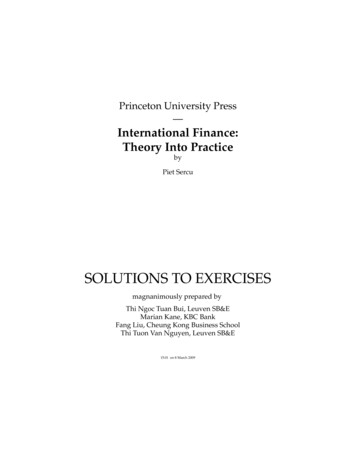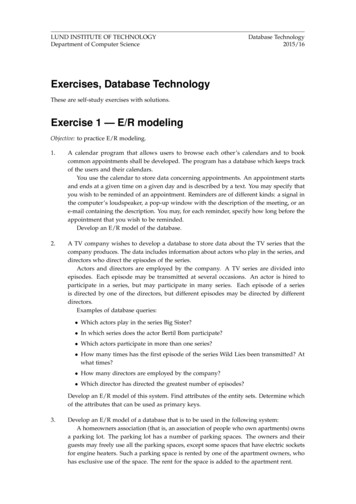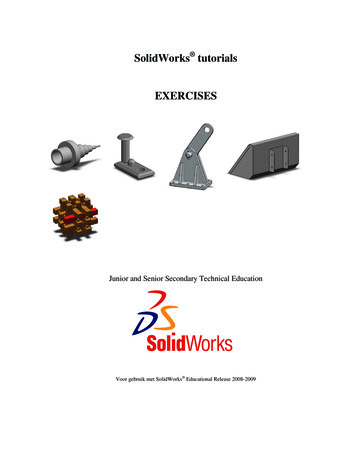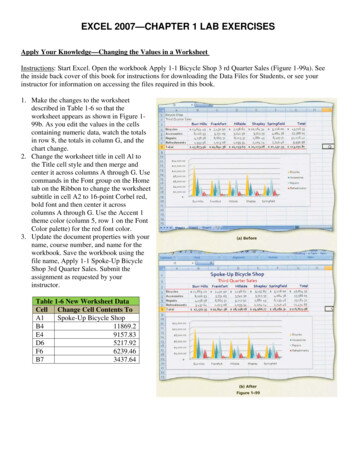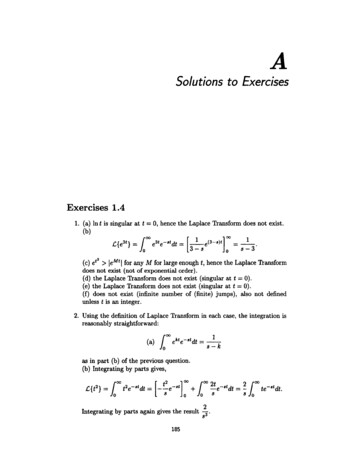
Transcription
ASolutions to ExercisesExercises 1.41. (a) lnt is singular at t 0, hence the Laplace Transform does not exist.(b)C{e3t } ;::::100oe3te-atdt;:::: [ 1 e(3-a)t ] 003-80;:::: 1 .8-3(c) et leMtl for any M for large enough t, hence the Laplace Transformdoes not exist (not of exponential order).(d) the Laplace Transform does not exist (singular at t 0).(e) the Laplace Transform does not exist (singular at t 0).(f) does not exist (infinite number of (finite) jumps), also not definedunless t is an integer.2. Using the definition of Laplace Transform in each case, the integration isreasonably straightforward:as in part (b) of the previous question.(b) Integrating by parts gives,Integrating by parts again gives the result185 .8
186An Introduction to Laplace Transforms and Fourier Series(c) Using the definition of cosh(t) gives.c{cosh(t)} {LX! ete-ddt LX! e- t e- 3t dt}1{ II} 28- 1 8 1882 - 1 .3. (a) This demands use of the first shift theorem, Theorem 1.3, which withb 3 is.c{ e- 3t F(t)} f(8 3)and with F(t) t2 , using part (b) of the last question gives the answer2(8 3)3'(b) For this part, we use Theorem 1.1 (linearity) from which the answer46- -828 - 4follows at once.(c) The first shift theorem with b 4 and F(t) sin(5t) gives55(8 4)2 25 - 82 88 41'4. When functions are defined in a piecewise fashion, the definition integralfor the Laplace Transform is used and evaluated directly. For this problemwe get.c{F(t)} LX! e- st F(t)dt 10 1 te-ddt 12(2 -which after integration by parts gives12 (1 - e- s ?85. Using Theorem 1.8 we get{ 2t}(a) .c ted1 d8 (8 2)(b) .c{tcos(t)}d8 d8 1 821 (8 2)21 - 8282)2 (1 The last part demands differentiating twice,2(c) .c{t cos(t)} 828 3 -68 d82 1 82 (1 8 2)3't)e-Itdt
187A. Solutions to Exercises6. These two examples are not difficuit: the first has application to oscillatingsystems and is evaluated directly, the second needs the first shift theoremwith b 5.(a) C{sin(wt lPH 1'X) e- Bt sin(wt lP)dtand this integral is evaluated by integrating by parts twice using the following trick. LetI 100e- 8t sin(wt lP)dtthen derive the formulafrom which1- ssin(lP) wcos(lP)-s2 W2M8-5(b) C{e cosh(6t)} (s 5)2 36 s-5 S2 -lOs -11·7. This problem illustrates the difficulty in deriving a linear translation plusscaling property for Laplace Transforms. The zero in the bottom limit isthe culprit. Direct integration yields:C{G(t)} roo e-otG(t)dt roo ae{u-b)8I a F(u)duioi-blawhere we have made the substitution t au b so that G(t) F(u). Interms of f (as) this isae- 8b f(as) ae- Bbr e- aot F(t)dt.i-blaO8. The proof proceeds by using the definition as follows:which gives the result. Evaluation of the two Laplace Transforms followsfrom using the results of Exercise 5 alongside the change of scale resultjust derived with, for (a) a 6 and for (b) a 7. The answers are
An Introduction to Laplace Transforms and Fourier Series188Exercises 2.81. If F(t) cos (at) then F'(t) -asin(at). The derivative formula thusgivesL:{ -a sin (at)} sL:{ cos(at)} - F(O).Assuming we know that L:{cos(at)} L:{-asin(at)}i.e L:{sin(at)} As aAs athen, straightforwardlysa sS2 - a-2 -1 - - -2S2 a2as expected.2. Using Theorem 2.2 givesIn the text (after Theorem 2.4) we have derived thatL:{lot Sin u) dU} tan-1 {;} ,in fact this calculation is that one in reverse. The resultis immediate. In order to derive the required result, the following manipulations need to take place:L: {Si (t) } LXi e-.t Si (t) dtand if we substitute ua t the integral becomes1 -"'1 00oThis is still equal to tan- 1e{ }.sin(au)- ud .uWriting p as then gives the result. (pis a dummy variable of course that can be re-Iabelled s.)3. The calculation is as follows:L: { [ p(v)dv }soL:as required.{lot IovF(U)dUdV} ;L: L:{p(v)}{IoVF(U)dU} sI2 /(8}
189A. Solutions to Exercises4. Using Theorem 2.4 we get! . { (t cos(au) - cos(bu) dU} 10U8100 u u .du3a2 u 2 b2 u 2These integrals are standard "In" and the result -;1 In(8822 a b22)followsat once.5. This transform is computed directly as follows . { 2 Sin(t)tSinh(t) }: . { et s n(t) } . { e- t s;n(t) } .Using the first shift theorem (Theorem 1.3) and the result of Exercise 2above yields the result that the required Laplace Transform is equal totan- 1C 1) - tan- 1 (8(The identity tan- 1(x) - tan-1(y) 1) tan- 1 C ) tan- 1 (;.;;y).has been used.)6. This follows straight from the definition of Laplace Transform:lim /(8)3- 00 lim[00 e- at F(t)dt3- 00 J0 [00 lim e- at F(t)dt. 00J0: o.It also follows from the final value theorem (Theorem 2.13) in that iflima- oo 8/(8) is finite then by necessity lim.- oo /(8) : O.7. These problems are all reasonably straightforward2(28 7)(a) (8 4)(8 2)31 8 2 8 4and inverting each Laplace Transform term by term gives the result 3e- 2t e- 4t·1 1y 8 921(b) S·Imlar82 9 : 8-3 - 8 3and the result of inverting each term gives 2e3t-and inverting gives the result112" 2" cos(2kt): cos 2 (kt).e- 3t
190An Introduction to Laplace Transforms and Fourier Series19swhich inverts to19(s 3)13(s 3)2 - (3t 1)e- 3t99·(d) This last part is longer than the others. The partial fraction decomposition is best done by computer algebra, although hand computation ispossible. The result is1(s - 2)2(s 3)31 -12-5('-s---'2) 2 -3625(s - 2)12 25(8 3)3 :'-:12 5(-;-s- 3) 23 625(s 3)e2te- 3tand the inversion gives 625 (5t - 3) 1250 (25t 2 20t 6).288. (a) F(t) 2 cos(t) -t 3 as t -t 0, and as - -2--1 we also have thats 8 81(s) -t 2 1 3 as s -t 00 hence verifying the initial value theorem.(b) F(t) (4 t)2 -t 16 as t -t o. In order to find the Laplace Transform,we expand and evaluate term by term so that sl(s) 16 8/s 2/s2which obviously also tends to 16 as s -t 00 hence verifying the theoremonce more.319. (a) F(t) 3 e- t -t 3 as t -t 00. f(s) - - - so that Sf(8} -t 3 ass 8 18 -t 0 as required by the final value theorem.(b) With F(t) t 3 e- t , we have 1(8) 6/(s 1)4 and as F(t) -t 0 ast -t 00 and 81(8) also tends to the limit 0 as 8 -t 0 the final value theoremis verified.10. For small enough t, we have thatand using the standard form (or the result on p50):with x 3/2 gives.C{sm(Vt)}and using that f{3/2} qVt} . f{3/2}-8 3/ 2 . (1/2)r{1/2} Vii/2 we deduce thatC{sin(Vt)} 2 2 .
191A. Solutions to ExercisesAlso, using the formula given,k1s3/2 exp - 4sk s3/2 .Comparing these series for large values of s, equating coefficients of s-3/2givesk Vi.211. Using the power series expansions for sin and cos givest4n 200sin(t 2 ) (-lt (2n I)!and00t 4ncos(t 2 ) L ( - l t2 -,.n.n OTaking the Laplace Transform term by term gives'"{ . (2)} ( )n (4n 2)!sm t -1 (2n 1)!s4n 3f 'oL,and {cos(t2)} (4n)!f ' (o -1 )n (2n)!s4n l·12. Given that Q(s) is a polynomial with n distinct zeros, we may writeP(s)AlA2AkAn-- -- -- . -- . -Q(s)s-als-a2s-aks-a nwhere the AkS are some real constants to be determined. Multiplying bothsides by s - ak then letting s - ak givesAk. hm a.P(s).(s - ak)Q( S )(s -ak) 8 a.hm P(s) Q().SUsing I'H6pital's rule now givesAt P(ak)QI(ak)for all k 1,2, . , n. This is true for all k, thus we have established thatP(s) P(ad1Q(s)Q'(ad (s - ad . P(ak)1QI(ak) (s - ak) .Taking the inverse Laplace Transform gives the result -1 {P(S)}Q(s) tP(ak) ea tk 1 QI(ak)sometimes known as Heaviside's expansion formula.P(an)1QI(a n } (s - an)
192An Introduction to Laplace Transforms and Fourier Series13. All of the problems in this question are solved by evaluating the LaplaceTransform explicitly.(a) C{H(t -an 1 e-otdt e-.00-a8a810 (t 1)e- 8t dt lOO 3e- st dt.2(b) C{h (tn Evaluating the right-hand integrals gives the solution)-1 -12 (28e- -1.8810 (t l)e- st dt 12(c) c{h(t)} 006e- ot dt.Once again, evaluating gives(d) As the function h(t) is in fact continuous in the interval [0,00) theformula for the derivative of the Laplace Transform (Theorem 2.2) canbe used to give the result !(e- 28 - 1) at once. Alternative, h can be8differentiated (it is 1 - H(t - 2)) and evaluated directly.14. We use the formula for the Laplace Transform of a periodic function Theorem 2.19 to giveJ;c e- Bt F(t)dtC{F(tn (1 e28C) .The numerator is evaluated directly:which after routine integration by parts simplifies toThe Laplace Transform is thusC{F( )}11 (-BC 1)21 1 - e- sct 1 e2BC 82 e 82 1 eSCwhich simplifies to812tanhG8C) .
A. Solutions to Exercises193Exercises 3.61. (a) IT we substitute u t - r into the definition of convolution then9*f-1becomes0 lot g(r)f(t -g(u - r)f(u)dur)dr 9 * f·(b) Associativity is proved by effecting the transformation (u, r) -t (x, y)where u t - x - y, and r y on the expressionf* (g * h) ll0tt0 -Tf(r)g(u)h(t - r - u)dudr.The area covered by the double integral does not change under this transformation, it remains the right-angled triangle with vertices (0, t), (0,0)and (t, 0). The calculation proceeds as follows:8(u, r)dudr 8(x,y) dxdy -dxdyso thatfi 10rt-z 1t[1t* (g * h) f(y)g(t - x - y)h(x)dydx0h(x)lt x-f(y)g(t - x - Y)dY] dxh(x)[f * g)(t - x)dx h * (f * g)and this is (f * g) * h by part (a) which establishes the result.(c) Taking the Laplace Transform of the expression f * f- 1 1 givesC{f}.C{f-l}from whichC{f-l} !8 81 8)using the usual notation (/(8) is the Laplace Transform of f(t». It mustbe the case that81 8)-t 0 as8-t00.The functionf- 1 is not uniquelydefined. Using the properties of the Dirac-8 function, we can also writeIt of(r)8(t - r)dr f(t)
194An Introduction to laplace Transforms and Fourier Seriesfrom whichClearly, J(t) 1 2. Since .c{J} o.J and .c{1} l/s we havels.c{J * 1} so that, on inverting.c- 1{?} * 1 fat J(r)drJas required.3. These convolution integrals are straightforward to evaluate:(a) t * cos(t) fat (t -r) cos(r)drthis is, using integration by parts1 - cos(t).(b) t * t(c)sin(t) * sin(t) lot sin(t -lto(t - r)rdrr) sin(r)drt3 -.6 lot [eos(2r -t) - eos(t)]drthis is now straightforwardly (sin(t) teos(t)).(d) et * t fat et- rdrTwhich on integration by parts gives-l-t e- t .t * eos(t) fat et-(e) eTcos(r)dr.Integration by parts twice yields the following equationlot et-Tfrom whichcos(r)drrt [e-Tsiner) - e- T10 et - T cos(r)dr1cos(r)] -lot et- "2(sin(t) -cos(t) e t ).Tcos(r)dr
195A. Solutions to Exercises4. (a) This is proved by using I'Hopital's rule as follows1 2 1:1: e -t2dt 2 d 1:1: e-t2dt· {erf(X)I1m- - } I'1m X:1:- 0 x.fi 0.fi dx 0:1:- 0and using Leibnitz' rule (or differentiation under the integral sign) this is.222hm-e-:I: :I:- o.fi.fias required.(b) This part is tackled using power series expansions. First note thate-:l: 2 1- x 2 -2! -3! . ( I)n 1 .n!462nIntegrating term by term (uniformly convergent for all x) gives1Vi2e-:l:dx t 1 / 2ot3/ 23t5 / 25.2!t1 /2 -- . (-lt 17.3!t n 1/ 2(2n 1).n! .from which(h) 2- ( 1-- -,--, "' tt2t3()n t 12erfvt-1 1.fi5.2.37.3.tn 1}.n., '"(2n).Taking the Laplace Transform of this series term by term (again justifiedby the uniform convergence of the series for all t) gives.c-1{C!erf(Vt)} .fiand taking out a factorget the required result:(! 1 1 2 . 7s838258 34(2n( I)n l}sn l1/-18 leaves the arctan series for 1/-18. . )Hence we5. All of these differential equations are solved by taking Laplace Transforms.Only some of the more important steps are shown.(a) The transformed equation is8X(S) - x(O) 3X(8) 1-28-from which, after partial fractions,x(s}1 s 3 1(s - 2)(8 3)4/51/5 s 3 s-2'
196An Introduction to laplace Transforms and Fourier SeriesInverting givesx(t)41 e e553t2t (b) This equation has Laplace Transform1(s 3)x(s) - x(O) 1sfrom which x(O)1/10 s/lO - 3/10.s 3 s 3s2 1The boundary condition x( 7I"} 1 is not natural for Laplace Transforms,however inverting the above givesx(s)x(t) (X(O) -and this is 1 when x 7r,110 ) e- 3t110 cos(t)- 130 sin(t)from which1x(O) - 109 3 e.10and the solution isx(t) e3( . -t)10- cos(t) sin(t).1010(c) This equation is second order; the principle is the same but the algebrais messier. The Laplace Transform of the equation isS2X(S)8 4sx(s) 5X(8) -2-1s and rearranging using partial fractions givesTaking the inverse then yields the resultx(t) e- 2t(cos(t) sin(t)) sin(t) -cos(t).(d) The Laplace Transform of the equation is(8 2 -3s - 2)x(s) -8 -1 3 8from which, after rearranging and using partial fractions,3x(s) -- (84(s 8-3)22!)17-"45(s -!)2 -
197A. Solutions to Exerciseswhich gives the solutionx(t) -3 4eitcoshGm) - eitSinh Gm).(e) This equation is solved in a similar way. The transformed equation is82 Y(8) - 38 y(8) -1from whichY(8)26 48 38 382 1 - 82 4 and inverting, the solutionyet) - sin(2t) 3cos(t) 3sin(t)results.6. Simultaneous ODEs are transformed into simultaneous algebraic equationsand the algebra to solve them is often horrid. For parts (a) and (c) thealgebra can be done by hand, for part (b) computer algebra is almostcompulsory!(a) The simultaneous equations in the transformed state after applyingthe boundary conditions are(8 - 2)X(8) - (s6 l)y(s) s 3 3(28 - 3)X(8) (s - 3)Y(8) 68 3 6from which we solve and rearrange to obtain4xes) (8 3)(s - 1)3s-1 (8 -1)2so that, using partial fractionsxes)giving, on inversion212 --3s- --1s- (s- 1)2x(t) 2e3t et 2tet In order to find yet) we eliminate dy/dt from the original pair of simultaneous ODEs to giveyet) -3e 3t - 45 x (t) 43 dxdt .Substituting for x(t) then givesyet) e 3t ette t
An Introduction to laplace Transforms and Fourier Series198(b) This equation is most easily tackled by substituting the derivative of -4 -y6x 2 sin(2t)into the second equation to giveJldx 6 dt x 4 cos(2t) 3e- 2t .5 dx 2The Laplace Transform of this is then5(S2X(S) - sx(O) - x'(O)) 6(sx(s) - x(O)) x(s) 24s 4 3 .
A. Solutions to Exercises 187 6. These two examples are not difficuit: the first has application to oscillating systems and is evaluated directly, the second needs the first shift theorem with b 5. (a) C{sin(wt lPH 1'X) e-Bt sin(wt lP)dt and this integral is evaluated by integrating by parts twice using the fol lowing trick. Let I 1



